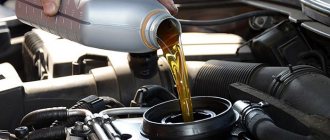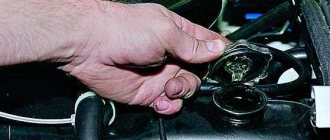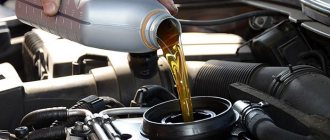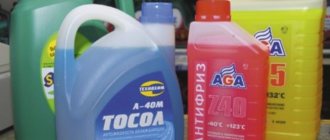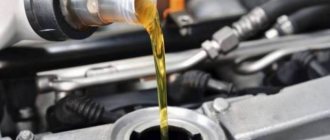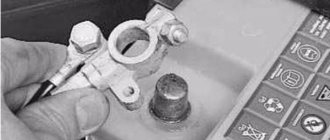Engine flushing. What do we know about this? There is a certain procedure aimed at cleaning the engine lubrication system, that is, the oil system, from certain contaminants, in which special detergent compositions are used. It seems simple!? But to whom, when and under what circumstances should it be performed? This is exactly what we will talk about now...
At first glance, everything is simple, the procedure seems like a real good and can provide an extremely positive effect. However, if this is so, then why is engine flushing so negatively perceived by some car enthusiasts? Maybe its merits and positive effect are exaggerated and its necessity does not make sense at all?
There are fierce discussions on thematic forums regarding engine flushing; there are a large number of supporters and opponents, who, in turn, have a lot of compelling arguments both for and against.
Whether it is necessary to flush the engine when changing the oil is one of the popular controversial issues. It is unlikely that it will be possible to answer this question unambiguously, since everything depends on a number of factors.
When to clean the engine
Flushing the engine with kerosene before replacing should not be done every time, as many service stations recommend, hoping to earn more money from you. The need for cleaning is determined based on the vehicle's mileage. As a rule, it is recommended to clean the engine every 70-80 thousand mileage. But in fact, no one does this, so to make control easier, we’ll set the bar at 100 thousand mileage. During this time, the surface and insides of the parts become overgrown with smudges and smoke, which must be removed, because all this reduces the power of the engine and affects its operation.
What cleaning methods are there?
Flushing the engine with kerosene before changing the oil can be done in other ways, more gentle and faster. Gentle cleaning is a more suitable option, because it does not cause any harm to the car. This is a fairly common cleansing practice. A special cleaning liquid is poured into the engine block and left there for a while, and with this liquid the car must cover 150-200 km.
Flushing the engine before changing the oil, a video of which you can view in the article, can be done periodically.
When the car has covered the required distance, it is returned to the service center, where the liquid is already drained, and along with it all the fumes and pieces of burnt material come out. As a result, the motor will work better and quieter, reception will be normalized and without interruptions, and elasticity will increase. With this procedure, it is also recommended to install new filters.
What are the dangers of a faulty cylinder head gasket?
If technical fluids are changed regularly, antifreeze is purchased from trusted suppliers and the same type is poured, the reason should be sought elsewhere. In situations where bubbling is clearly observed in the expansion tank while the engine is running, the cause of foaming is most likely a failed cylinder head gasket.
A burnt-out gasket compromises the tightness of the channels of the cooling and lubrication systems. As a result, the oil gets into the antifreeze and provokes foaming, and the liquid affects the motor lubrication in the same way. So an increased oil level, detection of light deposits or traces of antifreeze on the dipstick, and an oil film in the expansion tank will confirm the presence of a problem with the gasket.
In addition, exhaust gases break into the cooling system, which causes the antifreeze to boil. And the coolant that gets into the exhaust of a warm engine makes itself known with a characteristic whitish smoke similar to steam. If such signs are present, there is no longer any need to guess why the antifreeze foamed.
How to quickly get the job done
Flushing the engine before changing the oil, a video of which will help you become more familiar with the technology, can be done using the express method.
It is carried out according to the same principle. A cleaning agent is poured into the block, but now the car only needs to drive for 15-20 minutes before the liquid can be washed off. The aggressive substance, which is poured into the block, cleans the metal and all elements well under the influence of high temperature. Of course, many will say why careful cleaning is needed to take the car to the service center twice, if everything can be done in one day.
The fact is that the quick cleaning solution has a strong effect on the metal, increases its wear, and if you do this cleaning 3 times in a row, it can lead to deformation of small elements. Flushing the engine with diesel fuel before changing the oil, a video of which will allow you to understand how to eliminate mistakes, can be done by you yourself.
When is engine flushing not necessary?
There is no need to flush the engine in the following cases:
New car . You bought a car from a dealership and want to start using it. If the car is under warranty and you have a document confirming this, there is no need for you to take the initiative and wash anything anywhere. This, as they say, is a “headache” for the service station that will perform after-sales service. In your case, the most important thing is to clearly monitor the quality of work performed, as well as the schedule, so as not to accidentally miss scheduled maintenance.
Regular oil changes . If you do a routine engine oil change, you don't need to flush the engine every time, just change the oil and oil filter regularly. If you really want to, you can wash it every 10th replacement, for example, or more often, it all depends on a large number of factors.
When work is necessary
Quite often, car owners wonder when there is a need to carry out the work described in the article. This need may arise if you are planning to switch from one brand of motor oil to another. This can be attributed to their types of fuels and lubricants, since among them there are mineral, synthetic and semi-synthetic. Each of them may have a certain viscosity, and may also be manufactured by a different manufacturer. Each composition has its own unique additives, which should not be mixed with each other. If you purchased a car that was previously in use and do not know what fuels and lubricants the owner used, then it is best to carry out the work described, this will allow you to start the life of the engine from scratch.
How to flush the lubrication system on all VAZ cars?
1) Flushing is actually quite simple, you can find more details on how to flush the lubrication system with one or another flushing fluid on the jar itself in which the flushing fluid is located, usually all jars have instructions for their use and they are all used in different ways, some kind of flushing fluids need to be used by starting the engine of the car and letting it run for 15 minutes so that the remaining oil leaves the system, some kind of flushing fluids need to be mixed with the engine oil itself and then drive 100-200 km and thereby The engine will also be cleaned, so as you already understand, you need to look at the instructions on the jar of liquid as everything is described in detail on it.
2) But so that you don’t forget, always remember a few rules, namely, before purchasing a fluid, make sure that it is suitable for your oil, that is, the flushing fluid is for mineral oils, as well as for synthetic oils, etc., therefore, when choosing a flush, take this into account; in addition, also pay attention to which car engine the flush is used for and you do not need to take a flush for diesel cars if in fact you have a gasoline one.
Note! In addition, if you want to make the flushing better, then you can buy a new oil filter at the auto store and install it only for the time of flushing; it doesn’t make sense to buy something too expensive since you will only need to install it and then throw it away, so take a relatively cheap one a filter that would simply act as a plug (so that oil does not leak out of the engine), and it is recommended to install a new one during flushing only because your old filter is dirty and mixing the flushing fluid with dirt will only weaken the flushing effect and thus it will not as good as it should be!
Additional video clip: For more information on how to flush the engine lubrication system, see the video located just below, everything is described in detail.
Positive effect and possible negative consequences
Diesel fuel has excellent dispersing ability. That is, it dissolves even old deposits of various natures, including sludge. Therefore, many motorists 20-30 years ago actively used diesel fuel as a liquid for flushing engines. That is, in those days when engine parts were massive with an impressive margin of safety and minimal requirements for fuels and lubricants.
In addition, some diesel fuel, which will certainly remain in the engine crankcase, will not have a pronounced negative effect on the new oil. After flushing the engine with diesel fuel, it is not necessary to somehow expel the remaining diesel fuel from the crankcase or to fill and drain fresh oil several times.
This method of cleaning the motor is also relatively inexpensive. Compared with cleaning agents, and even more so with specialized oils, washing the engine with diesel fuel will be several times cheaper.
This is where the positive aspects of this procedure end. Let's briefly look at the possible negative consequences.
- Lumpy detachment of solid deposits. Sludge build-up accumulates on static surfaces in many motors. Diesel oil can simply separate them from the surface and dump them into a pan. Or run it into the oil channel. Which will cause partial or complete blockage and oil starvation of any friction pair.
- Negative impact on rubber (caoutchouc) and plastic parts. The vast majority of modern seals and retainers in engines made of plastic and rubber are resistant to the chemical effects of any petroleum products. But diesel fuel can completely destroy “tired” non-metallic parts.
- Possible damage to the liners and the formation of scuffing in the ring-cylinder friction pairs. Diesel fuel does not have sufficient viscosity to create any strong protective layer.
All these consequences have the status of probable. And they will not necessarily occur in every individual case.
Lambda Oil Primer.
Here is another interesting and super effective thing for flushing a car engine - Lambda Oil Primer.
This product is approved by TUV, ROHS and VAG. Works well in restoring engine compression. Many who used it were simply eager to do a compression test before and after use. The results were great after washing. Ideal cleanliness and operation of the motor, as well as its subsequent protection. Used in gasoline and diesel engines. One of the best premium washes in the world.
As for the product characteristics:
Effectively cleans the oil lubrication system, preventing problems associated with the accumulation of sludge, dirt, and deposits. After cleaning, clean oil in a clean engine is guaranteed for many kilometers. It is used both in the engine and in gearboxes and differentials. Contains a lubricant that protects mechanical parts during the cleaning process. Suitable for all types of modern and old gasoline engines. and design engines. added to any motor oil.
When changing the oil, many car enthusiasts resort to flushing the oil system. The operation of the engine is delicate and has its own nuances, which should be known to anyone who is going to do it on their own.
In what cases should you absolutely not wash your engine with diesel fuel?
There are two cases in which flushing the engine with diesel fuel before changing the oil is more likely to have a negative rather than a positive effect.
- A very tired engine with a lot of output. It is not without reason that some car operating instructions say that after a certain operating time (when the engine wears out and all the gaps in it increase), it is advisable to start filling in thicker oil. This is done to compensate for gaps due to the thicker and more durable oil film created by thick oil. Diesel fuel has a very low viscosity. And even with its short-term use, metal-to-metal contact in all loaded friction pairs will be irreversible. The result is accelerated wear to the limit and a high probability of jamming.
- Modern technological engines. There is no question of using regular oil with the wrong viscosity. And using diesel fuel as a flush at a minimum (even with a single fill) will significantly reduce the service life of the motor.
Using engine oil
Advice: Do not fill an engine that makes knocking or noise with expensive oil. You must first diagnose the device.
The opinion that if you rarely drive a car, then the oil does not need to be changed, does not correspond. If the engine is not started for a long time, condensation will collect inside, which, when mixed with oil, worsens its properties and increases wear on rubbing parts. So:
- You cannot start abruptly from a stop and accelerate the car too much, which also increases wear on parts.
- There are functional features of the oil. “Winter” should not be poured in summer and vice versa.
- The quality of the fuel used plays a role in the deterioration of oil properties. Residues of fuel that does not burn completely end up in the oil, which contaminates it.
Reviews from motorists who have tried the diesel fuel flushing method
Good reviews about the method of washing an engine with diesel fuel are mainly left by owners of outdated equipment. For example, drivers often wash ZMZ and VAZ engines with diesel fuel. Here, in most cases, there are no pronounced negative consequences. Although it is not a fact that in one wash the car owner did not reduce the engine life of thousands by 50 km.
You can also find negative reviews on the Internet. For example, after filling with diesel fuel, the engine seized. After disassembly, worn out and twisted liners were discovered.
Therefore, the conclusion about this method of cleaning the engine is this: you can use diesel fuel, but carefully and only on well-preserved outdated engines.
Flushing the engine with diesel fuel before changing the oil is an old, but reliable and simple way to clean the power unit.
Today, many drivers laugh at the “eccentrics” who use this washing method. Diesel oil makes it possible to remove dirt and carbon deposits without the use of aggressive additives.
You don’t have to worry about engine parts that can be damaged by aggressive influences. By flushing the engine with diesel fuel, it is possible to simply, inexpensively and safely extend the service life of the engine.
When is rinsing necessary?
When a vehicle is used, resin accumulates in the lubricating system of its internal combustion engine. Carbon deposits appear on the walls of oil channels, which can significantly impair oil circulation and reduce cooling efficiency. The situation is aggravated by pouring low-quality oil fluid.
All highways may become clogged. Every ten to fifteen thousand kilometers the car oil is changed. However, if the car was operated in harsh conditions with poor lubrication, then filling with fresh petroleum product will be pointless without cleaning the gasoline/diesel internal combustion engine.
It is necessary to flush the engine with diesel fuel before replacing the lubricant in the following situations:
- switching to a different type of motor oil;
- pouring lubricant into a newly purchased car (provided that you do not know the brand of oil that was previously filled);
- penetration of coolant or fuel into the oil liquid;
- completion of a complete overhaul of the power unit.
Engine oil and its purpose
The purpose of the lubricating fluid in the power unit is clear - reducing friction, timely removal of heat and ensuring reliable operation of all mechanisms.
Ideally, oil can last indefinitely. But! The car engine operates under constant overload conditions - high pressure, sudden temperature changes and mechanical stress.
Under such conditions, the oil begins to lose its properties and oxidize. Such “waste” ends up in a variety of places - deposited in engine gaps, oil grooves and other engine elements.
Each time the quality of the lubrication of the power unit becomes worse. This, in turn, affects the characteristics of its work. It turns out to be a chain reaction.
As a result of oil oxidation, a whole “bouquet” of foreign elements appears - resinous and carbon deposits, as well as acids. The action of the latter (acids) accelerates the process of corrosion formation and changes the characteristics of the oil.
Over time, the following appears on the internal elements of the engine:
- Sludge - inevitably leads to a deterioration in the characteristics of the oil and an increase in its viscosity characteristics;
- varnish - appears on the inside of the piston, connecting rods and fingers. Such “spraying” leads to deterioration of heat dissipation, a decrease in the strength of engine elements, and deterioration of their lubrication;
- carbon deposits cause the destruction of fuel and lubricant and have a dark color. Its occurrence can lead to frequent problems with engine cooling.
Against the background of the above material, the question of whether the engine needs to be flushed becomes even more relevant. Moreover, there are many versions.
Some experts recommend buying special flushing oil, others - ordinary mineral water, and still others are generally against any additional flushing processes. So who is right?
Features of the washing procedure
The main reason for washing the engine with diesel fuel is to completely cleanse the internal combustion engine of past lubricant and contaminants. Often, liquids are used for cleaning that can dissolve solids, resin and old oil residues. Usually, special additives are added to the car oil before draining.
You can also fill in the flushing agent after draining the used consumables. Today's flushes perform their task well, but they are expensive and considered quite aggressive. If they are added to the engine, they can destroy its parts.
How to flush the engine when changing the oil
If a flushing additive is used, it is poured through the oil filler hole. The engine is started and allowed to run for the time recommended by the manufacturer of the flushing composition. Then the engine is turned off, the old oil is drained, the oil filter is replaced and new oil is added.
If flushing oil is used, then the old motor oil is drained and flushing oil is added. Then drive the car for the washing distance recommended by the manufacturer. Afterwards the oil is drained, the oil filter is changed and new oil is added.
How is flushing performed?
The engine is washed with diesel after draining the old motor oil. Draining is performed as standard, through a hole in the crankcase pan.
- Place your car on an inspection ditch or a special overpass.
- Using a special tool, loosen the drain cap.
- Place a pre-prepared container under the drain.
- Remove the cover by sharply pulling it to the side. This is necessary so that the stream of oil is directed exactly into the container.
- Wait until all the consumables have been drained.
- Remove the car oil filter. This is usually done manually, but if necessary, you can use a key.
- Install a temporary oil filter. It is only necessary for the engine flushing procedure, so it is advisable to purchase the most inexpensive product.
- Quickly pour diesel into the internal combustion engine (you can mix it with lubricant or use kerosene). Three liters will be enough. The initial impulse of the filling jet is needed so that the diesel fuel spreads throughout the entire power unit. The diesel will pass through the lubricating complex and flow out of the drain. This will eliminate the most serious contaminants and waste oil residues.
- Close the oil pan drain cover.
- Pour diesel into the internal combustion engine. Pour as much diesel fuel as you usually pour lubricant.
- Run the engine for a short time to run it in boost mode.
- Make sure that the internal combustion engine does not reach operating temperature.
- Turn off the motor.
- Remove the drain cover.
- Drain the diesel engine. If you notice that dirt particles come out along with the last drops of diesel fuel, repeat the rinsing.
- When clean diesel fuel starts flowing from the drain, close the lid.
- Remove the temporary oil filter.
- Install a new oil filter for further operation of the vehicle.
- Fill with fresh oil.
- Check the power unit for leaks.
If you did everything correctly, then the washing can be considered complete.
Preparation
Sealing wiring connectors
Before you give your engine a bath, you need to properly prepare the car.
- Cover all electrically dependent units with films to prevent moisture from getting there.
- Prepare the necessary products and tools for washing your VAZ 2114. Here you will need brushes, rags, a large amount of water, and detergents. If you also have a dryer, that's great.
- Choose a location for washing. This cannot be done everywhere, since you may be fined for unauthorized car washes. You won't be able to do this in your garage. The best option is the courtyard of a private house. This is your territory, plus there is constant access to water.
